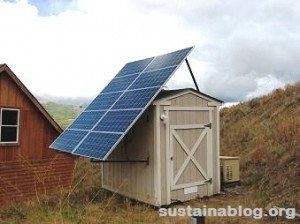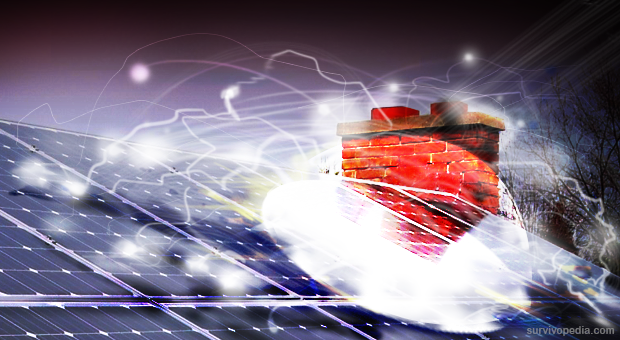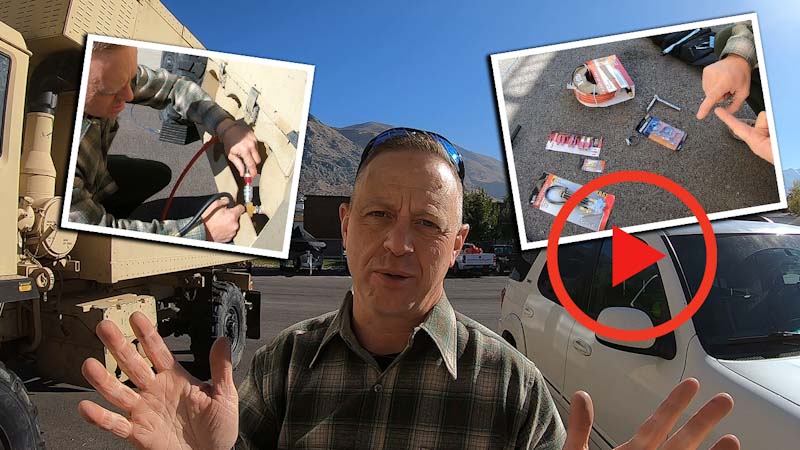Our country’s way of life and most people aren’t prepared to survive when an EMP will cripple the entire U.S. power grid and kill electric equipment in the entire country. Protecting your solar gear makes the big step ahead to your survival.
You might choose to start with an easy, inexpensive project right now such as constructing a DIY Faraday cage for your solar panels, or tuck a few mission-critical solar gadgets inside a couple of layers of Faraday bags to go in your rucksack. We already explained how to do it, in the first part of this article.
Next in increasing order of cost, complexity and difficulty, are solar panel installations on homes or retreats which are not connected to the grid. For this type of application we will shield the solar panels themselves, all associated wiring, inverter hardware, the battery bank and as little space as a couple of rooms or as much as the entire building.
How It Works
Shielding large spaces is most easily and least expensively accomplished in the design and building phases of the home and its solar power system as opposed to retrofitting an existing home and installing solar panels on it.
By creating a larger envelope of shielding, with the same shielding properties as a Faraday cage, all of the electronic devices in the shielded portion of the building will be protected. Shielding large spaces eliminates redundant purchases and the hassle of storing spare electronics in a Faraday cage for possible future use. Also, you don’t ned to shield dozens of devices individually nor install surge protection and shielded wiring between them.
To shield against the maximum theoretical EMP field strength (50 thousand volts per meter) of known NHEMP detonations, we must shield our solar panels to 74dB over a frequency range below 64Mhz.
But shielding them to 80dB will give us a margin of error since our shielding will likely become somewhat compromised over time and by the wear and tear of life and the elements.
Shielding Solar Panels for an Off-Grid Retreat

The entire roof, the exterior of all of the walls and the floor must all be shielded.
This will obviously be much easier to accomplish during the design and construction phases and can be accomplished by choosing conductive construction materials and methods which provide the needed shielding and lack of impedance, such as:
- Conductive metal roofing materials
- Conductive paint
- Conductive metal doors, door frames and conductive gaskets
- Conductive matting laid over the foundation or skin applied to the bottom of the sub-floor
- Conductive bonds, joints, brackets, gaskets and seals must be used to joint different materials
- Conductive window frames must be used
- Conductive window film or 2 layers of 20 opening per inch wire screening covering windows but still allowing light to pass through them and an unobstructed view will still providing the requisite level of shielding,
- 2 layers of conductive 20 opening per inch wire screening covering the solar panels will allow light transmission to the panels while still providing the requisite shielding. 2 layers will protect against construction mistakes and wear.
The outside skin of all walls must be shielded or the wiring within the walls will conduct the EMP into the electrical system. If less than the entire structure is shielded, the shielded rooms must be wired independently of the rest of the house or the use of costly fast-clamping surge protection equipment will be necessary to isolate the shielded rooms
The building should be properly grounded because of its large area.
Install micro-inverters underneath the shielded skin that envelops each solar panel instead of a single, and large inverter cabinet that rests on a cement pad next to the structure. You will increase redundancy and avoid shielding the inverter cabinets, and installing surge suppression and shielded wiring.
Shielding Solar Panels for a Grid-Connected Location
The most difficult and expensive solar installation is the protection of is a grid-connected home or building.
The same principles apply to this project as applied to the simpler projects but since the home and its solar energy system is connected to the power grid, this one requires additional protective measures.
This installation will be more vulnerable to the power charges induced by E3 because it is grid connected. For that reason, in addition to the measures taken in the previous projects, keep take good care of the following:
- The home’s connection to the power grid should have a mechanical, manual bypass circuit allowing the home to be physically disconnected from the grid.
- The home’s connection to the power grid must be fitted with the fast-clamping surge suppression previously mentioned.
- In order to deal with the power company, the home will need an electric meter. If a smart meter with a data connection is installed, the data connection would also need to be surge protected.
- Being more along the lines of a remote cabin, the last model was assumed to be pretty self-contained. Grid-connected homes typically have more connections penetrating the shielded envelope in addition to power such as copper phone lines, cable TV, satellite TV, radio antennas, etc.. An external cellular antenna will be necessary. A cell signal repeater located inside the shielded home will also be needed since virtually no signals of any kind will penetrate the home’s shielding.
- Non-conductive water and sewer pipes should be used where they penetrate the shielding envelope. EMP trapping baffles could be constructed where non-conductive pipe penetrations occur to reduce the amount of EMP entering through these points.
- Fiber optic cabling can be substituted for copper data and voice cable runs since fiber optic cable is non-conductive and will not conduct surges caused by E3 EMP inside the shielding envelope.
- Shielded foyers, mud rooms or rotating doors should be installed at entrances and exits. Passing through 2 shielded doors to enter the building, but allowing only 1 door to open at any given time will maintain the envelope. It would be a shame to go to all the cost and trouble of this level of protection just to have an EMP occur when the door is open and compromise the contents of the structure.
This last type of installation will raise the cost of a new home by about 30% including the cost of adding a solar installation with a battery bank and backup generator. But the added cost would be recouped over time through savings on future electrical bills and it is hard to put a price tag on piece of mind and the ability to maintain your standard of living after an EMP.
Of course, costs would increase for a retrofit in proportion to the complexity of the build and the amount of material needed.
With a little knowledge, insight and preparation, you can protect your solar panels from the effects of EMP. Whatever your income and the level of complexity of your solar installation, there is a solution.
Take this knowledge to prepare yourself or your family now so that you and yours are less vulnerable in the event of an EMP.
Find out which devices are most vulnerable to EMP on “Darkest Days”.









Pingback:How to Protect Your Solar Gear from EMP (Part 1) | May 30, 2014
|
Rooster | March 26, 2018
|
I have a solar setup at a off the grid cabin, if a solar cme were to hit the earth and we had a two hour warning , and I removed the charge controller along with the inverter and placed them in a metal trash can, would the panels be ok ? They are to big to store .
frank inscence | May 31, 2014
|
This is sooooooooo helpful because, EVERYONE I know is building a new house and they ALL have an extra 30% to add to the cost. It would be a real help to many real life people to have someone write an explaination for an INEXPENSIVE way to update one’s standing home or better yet, a storage closet where emergency electronics can be kept. I think that most people who are using solar panels want to protect their investment, but I am guessing that in these times of Obamanomics, the money is tight, which makes elaborate and expensive protection a nonentity.
Cache Valley Prepper | May 31, 2014
|
Frank Inscence,
This article is Part II of a II-part article. Part I lays out principles to guide the reader in constructing a DIY Faraday cage to protect solar gear. By applying them, the reader can build a Faraday cage out of materials that most people already have laying around their homes, can be easily scrounged up or that can purchased inexpensively. Part I also clarifies how to use Faraday bags to protect critical electronics.
Thanks for reading – CVP
Layinlow | December 18, 2014
|
How do I protect my solar gate opener unit. I can surround the unit but how do I protect the cord from the solar panel that charges the battery?
Cache Valley Prepper | December 24, 2014
|
Layinlow,
It sounds like you have a solar panel connected to a unit that opens and closes the gate by a cable. If you that describes the installation, you have two options:
1) Once you have shielded the unit, you can shield the cable or install a shielded cable, shield the solar panel. Keep in mind that the shielding of each component will have to bonded to the shielding of the component(s) it is connected to creating a shielded envelope or skin that will conduct EMP around the shielded components. The panel can be shielded with 20OPI conductive screening allowing light to penetrate to the panel, but depending on the production/consumption ratio, you may need a larger panel or a 2nd Gen panel since screening will affect the light transmission to some degree.
Option 2: Sounds like what you were suggesting, to sacrifice the panel, store extras and only shield the gate opener unit. In this case, you would need to install surge protector that has a clamping time of less than 1ms between the cable and the unit, right at the surface of the shielded envelope.
I hope that helps. Have fun with your project and thanks for reading and for your question.
Layinlow | December 25, 2014
|
Gosh, I feel so stupid when it comes to electricity. Thank you for your answer, sadly I don’t understand it completely, which is most likely because I didn’t “ask” clearly. I have a Mighty Mule 500. I have a 6 volt battery and a pc board encased in a plastic box, the cord from the solar panel runs up and atttaches someway to the battery. My fear is that if an EMP hits even if I surround the box that the charge will travel up the cord and fry my pc board. Am I saying it right? Thanks
Cache Valley Prepper | July 16, 2015
|
Yes, sir. Your suspicion that EMP could be conducted through power cord and unshielded portions of the installation. It will act like an antenna for the kind of EMP that occurs when nuke detonates high enough in the atmosphere.
I’m sorry if the example was overly complex. EMP a fairly complex topic sometimes I tend to include more detail than necessary for the engineers which is confusing to everybody else. I actually appreciate the feedback because that tells me that I’m probably not reaching a segment of readers. I will work on that. Anybody can over-complexify even an elegant example, but I appreciate writers who have the ability to make the complex understandable.
In order to create a shielded envelope or Faraday cage, you can’t have any holes in it larger than about 1/4″ and you can’t run cables or other conductors into it or they could conduct high voltage current past the shielded layer and into the rest of the installation. Think of it like a skin draped over a dumb bell. Nothing can come in or out or that really complicates the task beyond most people’s means.
But there is a solution. You have two parts to your gate opener with a cable between them, so think of it like a dumb bell. You would have to shield both the sides and the cable too. Otherwise the unshielded portion of your installation will act as an EMP antenna.
I hope that helps.
woody pennington | December 7, 2017
|
a alum. tool box from tractor supply is a good start on a good faraday cage .just remember to insulate the items stored inside from the skin of the box,use alum.tape on joints and double seal doors and hinges,
Papadon | June 1, 2014
|
Neat stuff! However, regarding shielding your entire house and solar installation, it seems impractical to wrap your entire home and solar installation in aluminum screen wire.
One practical solution I might offer is to hold off on your solar installation and stay on the grid until EMP takes it out. If an EMP never happens… Yay!
But if it does, Then, without power available, unwrap your insulated/faraday-cage-protected solar equipment and install it after the EMP has passed. Seems a bit easier to faraday cage a 4’x8′ pile of solar panels you’ve kept safe in storage than to wrap your home in screen wire.
Cache Valley Prepper | June 2, 2014
|
PapaDon,
I agree that it is easier and cheaper to protect stored solar panels than an active, installed solar array. This was Part II of a two part article. The first part was about protecting stored solar gear. I recommend reading that part too.
I realize that the vast majority of Americans don’t have much money to invest in an EMP-resistant off-grid home in this economy, but some do. But some of us will be building homes or cabins in the future and we can’t set a goal and save up to achieve it if we don’t even know that it’s possible.
The wire screening that you mentioned is only to cover solar panels and windows since they need light pass through them and you want to be able to see out of them. You also may be able to use a conductive, transparent film. The rest of the home or retreat would look just like any other since you can use attractive conductive building materials such as conductive paint and a conductive metal roof as the article points out.
Some folks baulk at a 30% increase in initial cost, but that includes the solar array, generator, battery bank etc. and will be recouped by not having to run a power line to your retreat, (and not having to grant right of way for repairmen to come onto your property to service it) not having to purchase a generator, not investing in panels to sit unused in storage, not having to buy an extra unit of every piece of critical electronics to store in a cage and not having to protect dozens of electronic devices individually. The article also points out that the portion of that 30% that is made up by solar panels and solar gear will be substantially cheaper in 10 years than it is today because of advancements in design and manufacture.
Thank you for reading and commenting!
– Cache
HEnry | June 2, 2014
|
I appreciate this and the first article. I would like to add something they may help some people who are struggling with the concept of EMP. In order to produce electricity you need three things. 1) An electromagnetic field. 2) a current carrying conductor. 3) and relative motion between the two. A little clarification of part 2. If you can connect power to this piece of metal and you would get shocked if you touch it then it is a current carrying conductor. The EMP covers the other two pieces of the puzzle. If you are reading this article then you are concerned about protecting your equipment. This article is the best one I have found about this subject. It did not provide any of the BS that I have found in other EMP protection help. Thanks for the article Cache.
Cache Valley Prepper | June 2, 2014
|
Henry,
Thank you for the insight and the compliment. It’s easy to get so deep into some topics that you lose sight of the basics.
Thanks for reading and thanks for commenting,
-Cache
ADStryker | June 11, 2014
|
You don’t need “3) relative motion” if you have “1) an electromagnetic field.” Inducing a current requires a time-changing field, and an EM field is, by definition, a time-changing field. You need motion to generate a time-changing field only if the field in question is intrinsically static (e.g., current is induced in the rotor of a permanent-magnet generator only when the rotor is spun by an external force — no current is induced when the rotor is stationary relative to the static magnetic field). An EMP is intrinsically a time-changing field.
Great Grey | December 24, 2014
|
#3 is very necessary. Just because it caused by changing field strength doesn’t mean there no motion between them, it is how transformers work.
Pingback:How to Protect Your Solar Gear from EMP (Part 2) | DIY Prepping | June 3, 2014
|
Sean1 | June 5, 2014
|
Can I buy conductive paint or conductive window films at the local hardware store?
I would assume that ordinary aluminum window screen doesn’t have enough conductors per inch to be very effective from the article above. True?
Also, I think a good test would be to put your cell phone in the cage (of whatever size) and call the phone from another phone. If it rings, you cage isn’t good enough. What do you think?
Thanks!
Cache Valley Prepper | June 11, 2014
|
Sean,
If you use a conductive film, make sure that it provides enough shielding on the outside, is insulated on the inside and that you bond it to the rest of the skin of the structure. Where materials meet really needs the most attention to detail. Overlapping conductive materials is best. It’s the openings per inch that you’re looking for if you use mesh screening. Calling a phone inside the cage or setting a radio inside the cage are good experiments to understand how the shielding works, but the phone signal will only be on one frequency so it wouldn’t mean that E1 or E2 wouldn’t penetrate since EMP’s frequency range is so broad and will also be more powerful. So you’re thinking along the right lines. It would be a good proof of concept, but if wouldn’t guarantee shielding across the entire frequency range or as much power. I hope that helps. Thanks for reading and for your question. – Cache
Sean1 | June 11, 2014
|
Thank you! One more question: how do I know if the conductive film provides enough shielding?
Cache Valley Prepper | June 11, 2014
|
On film, you’ll have to either buy film specifically manufactured for the purpose of shielding (in which case they will advertise how much shielding it provides) or find out what conductor the film uses and how thick it is. From there you can research how much shielding will be provided by a certain thickness of a given conductor.
Unfortunately, power company lawyers, lobbyists, regulating bureaucrats on the take and crooked politicians on the take are doing everything they can to suppress non-military information and even freedom of information act requests on the threat of EMP. This has kept shielding technology that is very well understood by the military engineers, and has been manufactured for decades, our of civilian hands. So we have had to reinvent the wheel so to speak. But EMP advocates are making steady progress. AZ just passed legislation to make EMP shielding information available to the public and hopefully the rest of the nation will follow suit and get the Shield Act passed. This is the most urgent threat facing humanity. It is shameful and abhorrent that this continues in spite of the fact that knowledge of the EMP threat has been in the public domain for so long. The talking heads continue to babble about the economy, but the economy won’t matter soon as we’ve been living on borrowed time for decades now.
Sean1 | June 12, 2014
|
Thanks again very much. That is very informative, I didn’t know the govt was suppressing this info, but it figures, doesn’t it? Thank God I have conservative reps (KS) who will definitely hear from me.
Pingback:How To Lower Your Heating Bill in 4 Steps | Survival skills, survival guns, survival guide | October 15, 2014
|
Cache | August 16, 2017
|
Sean1,
IT’s more NERC and the power industry that are actively putting out junk science about EMP, HEMP.
Then you have scientists putting forth their personal opinions as to why rouge dictators, soldiers and radical jihadis would never strike with HEMP. The problem with that is that their paradigm of human nature is largely based on their paradigm of self, so since they wouldn’t do it, they imagine that no one else would, because they must be just like the scientist or at least follow the same reasoning. This is naive in the extreme.
Rog | July 14, 2015
|
I have a couple solar panels in storage in their original cardboard box.
I want to protect these items. What is a better/best material to use around the box? Do I build a frame around the cardboard box and then put something around the box?
I was looking at 1/4 inch galvanize hardware cloth or a fine mesh aluminum screen. Which would be better to use for protection of EMP?
Lars Mars | February 26, 2016
|
“Conductive window film or 2 layers of 20 opening per inch wire screening covering windows but still allowing light to pass through them and an unobstructed view will still providing the requisite level of shielding,
2 layers of conductive 20 opening per inch wire screening covering the solar panels will allow light transmission to the panels while still providing the requisite shielding. 2 layers will protect against construction mistakes and wear.”
Cache | August 16, 2017
|
Rog,
Sorry About the caps but can’t seem to turn them off. IF the panels are just going to be stored until you need them, test them first to make sure they work. Best case would be to put the the box inside a container like a galvanized metal trash can. The Behren’s brand has a tight fitting metal lid to keep out rodents. as long as no gaps exceed .25″ it will provide quite a bit of shielding. Nested shielding and alternating layers of conductor/non-conductor would be best, but the box would protect the panels from the conductive trash can. Between galvanized hardware cloth and fine mesh aluminum screening, I would definitely go with the screening for conductivity. Make sure you overlap the edges and completely envelope the box..
Lars was helpful to post the specs below so I won’t repeat that.
Thanks for reading and for the question! investing in the ability to generate power is a responsible thing to do.
DPerks | November 4, 2022
|
Hi, wondering if you are still responding to these questions . . . if so, could you wrap the box the solar panels are in (and even the panels themselves, which are in foam, then in the carboard box) in heavy duty aluminum foil? Same with a portable inverter? A metal trash can is not large enough for what I have. Thank you!
Pingback:How To Heat Your Home Without Electricity | Survival skills, survival guns, survival guide | November 12, 2015
|
Pingback:5 Small Power Sources To Choose For Your Electronics | Survivopedia | December 8, 2015
|
Pingback:5 Small Power Sources To Choose For Your Electronicsdisasterdefense.us | disasterdefense.us | December 8, 2015
|
Pingback:Earthquake Survival: How To Restore Your Electricity - Backdoor Prepper | January 20, 2016
|
Pingback:How to Heat Your Home Without Electricity – The Prepper Dome | March 17, 2016
|
Pingback:EMP Survival: 3 Ways To Build A Faraday Cage | Survivopedia | December 5, 2016
|
Ruth Aspen | August 8, 2017
|
I live on the front range in so colorado in a 26 ft metal travel trailer. It seems overwhelming to protect so I scraped together money to Put up a 5×6 tough shed with one window and metal roof. I purchased a 160 watt zamp solar portable solar panel with charger attached and a 600 watt inverter and one battery. I dont understanD how to protect the solar wiring on panels which are on the ground and in use. I am getting the paint and metal for window. After I insulate it should I put metal screen under the wall covering? Also if I am not entering during the emp do I need to make a foyer? 68 yr woman alone and trying to get it together. Theres not enough info on survival shed backups for low income preppers! I am trying to learn about it all and no one I know is preparing or believes we need To! Thanks and I appreciate youR help.
Cache | August 16, 2017
|
Ruth,
shielding a travel trailer is an extremely involved project. Please see my article on the obstacles to shielding a quonset hut in the link below, which presents many of the same obstacles to construction using sections of sheet metal which are painted and joined. Basically, you probably will not be able to achieve a good skin effect because the glue and paint between the panels that keeps them waterproof and from rattling is probably not conductive and prevents proper conductive contact between panels or sections.
Maybe you can put some backup microelectronics and lighting in a Faraday cage instead.
Hope that helps and thanks for the question.
http://www.survivopedia.com/quonset-into-emp-shielded-home/
Missouri Bob | October 30, 2018
|
You mentioned an EMP trapping baffle. I could find not information about how this would work. Did you mean your shielded entryway/foyer/airlock? Thanks.